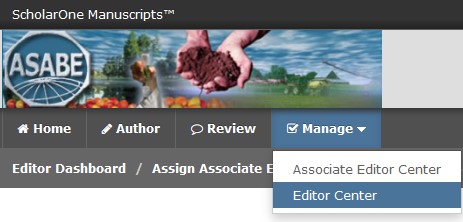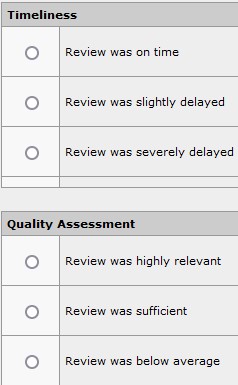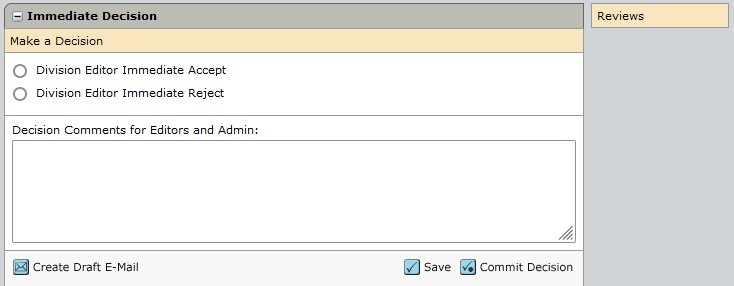Introduction
All Community Editors (CE) are members of the P-511 Journal Editorial Board and the Editor in Chief (EIC) is the chair. Occasionally, the Community Editor may be referred to by the old name "Division Editor," for example in ScholarOne.
Special collections in progress are listed on each journal home page. We generate an automated report for a collection and send it to you periodically unless you opt out. We also have a list of completed special collections and a web page to help special collection organizers.
Please review our Best Practices for Editors designed to reduce the peer-review time without sacrificing quality. A report on associate editor (AE) performance will be emailed to you monthly. We can schedule it to be sent at other times. Quarterly conference calls are held by the EIC for all community editors typically held in January, April, July (at AIM), and October to review performance and other matters. See our website for the CE FAQ and more details on being an editor.
Each CE should meet with their AEs at least twice per year. The CE should bring their ideas and concerns to the P-511 meetings.
Most CE are also the chair of their community's publications committee as listed below. These committees are responsible for picking the winners of the Superior Paper Award in March. CE also nominate AE for the Outstanding AE Award in March and may have other duties.
- EOPD-04 Refereed Publications Review and Paper Awards
- ES-04 Publications Review
- ESH-04/1 Journal of Agricultural Safety and Health
- ITSC-04 Publications Review and Paper Awards
- MS-04 Publications Review
- NRES-05 Publications Review
- PAFS-05 Publications Review
- PRS-04 Publications

ScholarOne Manuscripts
The ScholarOne Manuscripts website handles the peer-review process from submission to acceptance. You may also hear it referred to as "Manuscript Central" or abbreviated as S1. For ScholarOne video tutorials, user guides, and free one-on-one training, visit ScholarOne Training.
If you see a notification about pop-up blockers, please follow the on-screen instructions about enabling pop-ups for the site. You may not be able to view secondary browser windows such as PDF or HTML proofs.
Our test and development copy of ScholarOne is available for you to try. It is copied from the production system every weekend. Feel free to train and experiment using it using the same credentials for login as production.
https://mc-impl.manuscriptcentral.com/asabe
Most questions are answered within ScholarOne, usually at the top of each web page. If you have other questions, please email ManuscriptCentral@asabe.org. Questions and feedback are very helpful.
When a manuscript is ready for your attention, an email will be sent to you. Please be sure that your email system does not filter out ScholarOne (manuscriptcentral.com) or ASABE (asabe.org) email. In ScholarOne, when viewing the details of a particular manuscript, the Audit Trail tab (left side) shows all emails that have been sent. If you are not receiving these emails, please email ManuscriptCentral@asabe.org.
Under the Manage menu in ScholarOne Manuscripts, your account will have both a community Editor Center and an Associate Editor Center alongside your Author and Review centers.

Check your Editor Center frequently for any manuscripts awaiting your attention. Also, please rate AE and reviewers using the R-score. Outstanding AE and reviewer awards are presented annually and this score is used as part of the process. When viewing the recommendation, you can provide the R-score. There are two questions, each with a score of one, two, or three. The average of the two scores is used for the awards.

In general, as a CE, your task will be to assign each manuscript to an Associate Editor (AE). The AE works with reviewers, and, after their review, routes the manuscript with a recommendation back to the CE, who makes the decision (accept, reject, revise) and communicates the decision to the author.
The CE reads manuscripts before assigning to an AE. In some cases, the CE may decide to immediately reject (desk reject) a manuscript.

A CE can also act as an AE or a reviewer on a manuscript. You can assign a manuscript to yourself as an AE. Then, go to your Associate Editor Center and assign reviewers. If you assign yourself as a reviewer, go to your Review center to submit the review. If the CE is an author on a manuscript, the EIC or another CE can be assigned as CE for your manuscript. To appoint a short-term Guest Community Editor to either review a manuscript that you coauthored or manage a special collection, email the ASABE Manuscript Administrator, ManuscriptCentral@asabe.org. We do not expect a CE to regularly perform all of these roles, but want you to know that it can be done.
As AE, when the number of reviews required (default is three for new submissions, one for revisions) to make decision is fulfilled, on the Details page, the tab at the top right changes from Select Reviewers to Make Recommendation.
Changing the number of reviewers required can change this tab. The
Progress box for "# of reviews required to make decision" is on all three screens--
Details, Select Reviewers, and Make Recommendation. It is common to change the number of required reviewers when it is difficult to find enough reviewers or fewer reviewers are needed after the first revision. After the first review, editors sometimes choose to have one or two reviewers.

Unless you ask us not to allow automatic due date extensions for manuscripts under revision, we will approve all 31-day extensions as soon as requested by the author.
In ScholarOne, Crossref iThenticate similarity check automatically evaluates new manuscripts to detect potential plagiarism. This software creates an originality report and displays a similarity index (%) that is a general indicator. Do not use the similarity index by itself to make your evaluation. Only the original submission is checked, not revisions. If you need a report on a revision, contact ManuscriptCentral@asabe.org. You may receive a report from ASABE staff that a manuscript needs additional review due to a high score. You can review the report for all of your new manuscripts submitted since about February 2017. The tool allows review of the source documents. There is a link to the iThenticate User Guide on the web page near the report. We prefer to use “similarity” instead of “plagiarism” in communications with authors.
